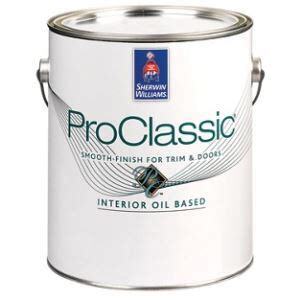Is Oil-Based Paint Better for Trim?

Key Features
- Durability and Finish – Oil-based paint provides a hard, smooth finish, perfect for high-traffic trim and woodwork.
- Low-VOC and Fast Drying – Water-based paint offers faster drying and lower VOC emissions, suitable for indoor projects.
- Cleanup Convenience – Water-based paint allows easy soap-and-water cleanup, while oil-based paint requires solvents like mineral spirits.
When it comes to painting trim, homeowners and contractors alike face an important decision: Should you use oil-based paint or stick with a water-based option? Trim requires a durable, smooth finish, and choosing the right paint is essential for achieving that polished look. So, is oil-based paint better for trim? Let’s dive into the pros, cons, and best practices to find out.
Why Is Trim Paint So Important?
Trim is often overlooked, but it plays a key role in tying a room’s design together. It gets a lot of wear and tear—think of baseboards, door frames, and window casings that take regular hits. That’s why trim paint must be durable, smooth, and resistant to scuffs. Whether you’re painting new trim or freshening up old woodwork, selecting the right type of paint will ensure it stays looking sharp for years.
What Makes Oil-Based Paint a Popular Choice for Trim?
Oil-based paint has long been favored for trim, and for good reason. It provides a tough, smooth finish that’s hard to beat. Here are the key benefits:
- Durability: Oil-based paint creates a hard, protective layer that stands up well to wear and tear, making it ideal for high-traffic areas like trim.
- Smooth Finish: The thicker formula allows it to self-level, meaning fewer brush strokes and a more professional look.
- Superior Adhesion: It bonds better to surfaces, including wood, metal, and previously painted trim.
- Stain Resistance: Oil-based paint resists stains and dirt, making it easier to wipe clean without damaging the surface.
These benefits make oil-based paint a go-to for trim, especially when a smooth, high-gloss finish is desired. However, it’s not without its drawbacks.
Things to Know
- Surface Prep Matters – Sanding and priming are essential when switching from oil-based to water-based paint.
- Durability vs. Speed – Oil-based paint lasts longer, but water-based paint dries faster and has less odor.
- Gloss Level – Oil-based paints generally provide a higher gloss finish than water-based alternatives.
- Cleaning and VOCs – Water-based paint allows easy cleanup and has fewer VOCs, making it better for indoor air quality.
- Choose Based on Use – For high-traffic or older wood trim, oil-based paint is ideal. For fast jobs or eco-conscious projects, water-based is the way to go.
What Are the Downsides of Oil-Based Paint?
While oil-based paint has its perks, it does come with some challenges:
- Longer Dry Times: It can take 24 hours or more to dry between coats, which can delay a project.
- Strong Odor: Oil-based paint contains more solvents, resulting in a stronger odor that requires proper ventilation during application.
- Cleanup with Solvents: You’ll need mineral spirits or paint thinner to clean brushes, which isn’t as convenient as water cleanup.
- Environmental Concerns: Many oil-based paints contain higher levels of VOCs (volatile organic compounds), which can be harmful to indoor air quality.
Considering these factors, some homeowners and painters opt for water-based paints instead. But does that mean water-based is better for trim?
How Does Water-Based Paint Compare for Trim?
Water-based, or acrylic-latex, paint has come a long way in recent years, with advanced formulas offering better durability than ever before. Here’s how it stacks up:
- Faster Dry Times: Water-based paint dries to the touch in a few hours, speeding up the project.
- Low Odor: It produces less odor, making it more comfortable for indoor use.
- Easy Cleanup: Brushes and rollers can be cleaned with soap and water.
- Low VOCs: Most water-based paints are low in VOCs, making them a more environmentally friendly choice.
However, water-based paint doesn’t always provide the same hard finish as oil-based. While it’s more scratch-resistant than before, it still may not match the durability of an oil-based coat—especially for trim that sees frequent use.
When Should You Use Oil-Based Paint on Trim?
There are specific scenarios where oil-based paint may be the best choice for trim. These include:
- Older Homes with Wood Trim
If your home has original wood trim, oil-based paint can bring out the richness and grain while providing lasting protection. - High-Gloss Finishes
Oil-based paints are ideal for achieving a high-gloss finish with minimal brush marks, giving trim a sleek, polished appearance. - Heavy Wear and Tear Areas
In busy households with kids or pets, oil-based paint provides the extra durability needed to keep trim looking fresh. - Touch-Up Projects on Previously Oiled Trim
If the trim was originally painted with oil-based paint, it’s best to use the same type for touch-ups to ensure proper adhesion.
In Our Experience
"We’ve found that while oil-based paint offers unmatched durability and gloss, the convenience of water-based paint can’t be overlooked—especially for indoor projects. If you need to finish quickly or care about eco-friendliness, water-based paint is a solid choice. However, for older homes or areas with heavy wear, oil-based paint is still the gold standard for trim."
Can You Paint Over Oil-Based Paint with Water-Based Paint?
Yes, you can switch to water-based paint, but there’s a catch. Proper preparation is essential to ensure good adhesion. Here’s what you need to do:
- Clean the Surface: Remove dirt, grease, and any loose paint.
- Sand Lightly: Sand the trim to dull the glossy surface and help the new paint stick.
- Prime: Use a bonding primer specifically designed to adhere to oil-based surfaces.
- Apply the Water-Based Paint: After the primer dries, you can paint with water-based paint.
Which Paint Is Better for Trim: Oil or Water-Based?
Choosing between oil-based and water-based paint ultimately depends on your priorities. Here’s a quick comparison:
| Feature | Oil-Based Paint | Water-Based Paint |
|---|---|---|
| Durability | Superior | Good |
| Dry Time | 24+ hours | 4-6 hours |
| Cleanup | Mineral spirits needed | Soap and water |
| Odor | Strong | Low |
| Finish | Smoother, glossier | Less glossy, but smooth enough |
| Environmental | Higher VOCs | Low VOCs |
My Recommendation for Trim
If durability and a flawless finish are your top priorities—especially in high-traffic areas like door frames or baseboards—oil-based paint is worth considering. Just be prepared for the longer drying time and the need for mineral spirits during cleanup.
On the other hand, if you prefer a low-odor option that’s easier to clean and better for the environment, high-quality water-based paint might be the way to go. Look for paints labeled as “trim and door” or “high-durability,” as these are specifically formulated for woodwork.
Final Thoughts: Which Paint Wins for Trim?
Both oil-based and water-based paints have their place when it comes to trim. If you’re working on a high-use area or restoring older wood trim, the durability and smooth finish of oil-based paint can’t be beaten. But for quicker projects or eco-conscious homeowners, water-based paints now offer a strong alternative that’s easier to work with.
No matter which type you choose, investing in high-quality paint will pay off in the long run, keeping your trim looking fresh and beautiful for years to come.
Do You Have Questions? Give Us A Call With Any & All! 503-389-5758
-
People Also Ask:
Is oil-based paint better for trim than water-based paint?
Oil-based paint offers a smoother, glossier finish and superior durability, making it ideal for high-traffic areas. Water-based paint is easier to clean and eco-friendly.
How do you switch from oil-based paint to water-based paint on trim?
Clean the surface, sand lightly, use a bonding primer, and then apply water-based paint for a smooth transition. Proper prep ensures good adhesion.
What type of paint is best for trim in older homes?
Oil-based paint is often the best choice for older homes with wood trim. It enhances the wood’s natural grain and provides lasting protection.
-
SUBSCRIBE TO OUR BLOG: Stay informed with the latest in Painting and DIY projects by subscribing to Lightmen Painting. Get insights, tips, and more delivered straight to your inbox. We would also love to know what you would like to read about, leave thoughts on where we should go next. Interests, Topics, Ideas, all are welcome.
Get $3000 in personal assistant credits from Magic .com
^ Click Our Logo Above To Redeem ^
If your in the Portland, Or. area and need advice or a free no obligation estimate call us at 503-389-5758 or email scheduling@lightmenpainting.com
Shout Out:
Celebrating Emerald Painting: Sunderland's Top-Rated Residential Painting Experts
From the team at Lightmen Painting, we extend our highest praise to Emerald Painting for their commitment to delivering exceptional residential painting services in Sunderland. Just as we are dedicated to excellence in every project, Emerald Painting focuses on exceeding customer expectations with high-quality craftsmanship and reasonable pricing. Their dedication to enhancing homes with outstanding service aligns perfectly with our mission to provide top-tier painting solutions that beautify and protect.
Thanks for stopping by Lightmen Daily! Stay tuned for more practical tips and expert advice on making your painting projects flawless, from wall to floor!
Definitions
- Acrylic Paint: A type of paint made with a synthetic resin as the binder, known for its durability and ability to resist weathering.
- Latex Paint: Water-based paint, which uses synthetic polymers as binders. Known for its quick drying time and ease of use.
- VOCs (Volatile Organic Compounds): Organic chemicals that have high vapor pressures at room temperature and can affect indoor air quality.
- Sustainability: Measures how environmentally friendly a paint is, considering factors like VOC levels and the impact on indoor and outdoor environments.
- Durability: The ability of paint to withstand wear, pressure, or damage; crucial for paints used in high-traffic or exposed areas.
- Flexibility: Refers to a paint’s ability to expand and contract without cracking, essential for outdoor applications.
- Ease of Application: How simple the paint is to apply, including factors like drying time and required equipment.
- Longevity: The length of time paint will last before it needs a touch-up or repainting.
- Cost-Effectiveness: Evaluates the initial cost versus the long-term benefits of a paint, including maintenance and frequency of repainting.
- Environmental Impact: Considers the effects of paint products on the environment, focusing on factors like VOC emissions and sustainability.
Lightmen Painting Serving: Portland, Tigard, Lake Oswego, Tualatin, West Linn, Milwaukie, Sherwood, Happy Valley, Oregon City, Beaverton, Hillsboro, Gresham -Trade Partners-

